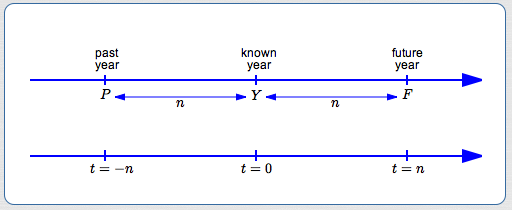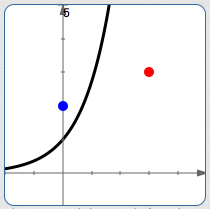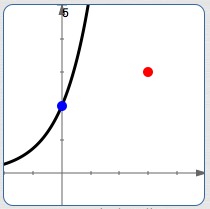 Exponential Growth and Decay: Introduction
Exponential Growth and Decay: Introduction
Exponential functions are of the form $\,y = b^t\,$ for $\,b \gt 0\,$ and $\,b\ne 1\,.$
For $\,b \gt 1\,$ they are increasing, and are called exponential growth functions.
For $\,0 \lt b \lt 1\,$ they are decreasing, and are called exponential decay functions.
All exponential functions share common behavior: when the input changes by a fixed amount, the output gets multiplied by a scaling factor.
It might be that every hour (the fixed input change), something doubles (gets multiplied by $\,2\,$). Or, it might be that every three seconds (the fixed input change), something gets halved (multiplied by $\,\frac 12\,$).
In general, increasing exponential functions get big fast, and decreasing exponential functions get small fast.
A typical exponential growth/decay problem often has this flavor:
A population has a given initial size. Later, it is bigger (or smaller). Assuming exponential behavior, what is its size at some future time?
There are a couple things that can make exponential growth/decay problems seem tricky.
First of all, a ‘basic’ exponential function may need to be generalized, using both vertical and horizontal stretches.
Secondly, the generalized exponential functions go by lots of different names.
You might see a problem solved in different ways, and wonder ‘which is right’. They're all right! Different people choose different names to work with! These issues are discussed in this section.
Choose $\,t = 0\,$
For exponential growth/decay problems, we call the input $\,t\,$ (for ‘time’) instead of $\,x\,.$ Populations change with time; populations are a function of time. The notation $\,P(t)\,$ denotes the size of a population at time $\,t\,.$
You always have an initial choice to make—what you call ‘time zero’—the ‘origin’ for time. Some people choose the earliest time when a population is known to correspond to $\,t = 0\,.$ It doesn't matter, as long as you are consistent throughout the entire problem.
Suppose $\,t=0\,$ is chosen to correspond to time $\,Y\,$ (think ‘year’):

Then, for $\,n \gt 0\,$:
- $\,t = n\,$ corresponds to $\,F = Y + n\,$ (future)
- $\,t = -n\,$ corresponds to $\,P = Y - n\,$ (past)
Going the other direction, for $\,F \gt Y \gt P\,$:
- a future $\,F\,$ corresponds to positive time $\,t = F - Y\,$
- a past $\,P\,$ corresponds to negative time $\,t = P - Y\,$
Generalizing $\,y = b^t\,$ to Handle Typical Exponential Growth/Decay Problems
Pick any allowable value of $\,b\,.$ The sketches below assume $\,b \gt 1\,,$ but the discussion holds for any $\,b \gt 0\,,$ $\,b\ne 1\,.$

A typical exponential function, $\,y = b^t\,.$ It may not have the correct initial size (the blue point). It may not have the correct second known size (the red point).

Do a vertical scaling
to get the correct initial size:
$y = P_{0}\,b^t$

Do a horizontal scaling
to get the correct second known size:
$y = P_{0}\,b^{st}$
The exponential function $\,P(t) = b^t\,$ is too restrictive for exponential growth/decay problems. We need to allow for any initial population size. (The ‘initial population’ is the size at $\,t = 0\,.$ ) However, $\,P(0) = b^0 \,\overset{\text{always}}{=}\, 1\,.$ We don't always have an initial population of size $\,1\,$!
To solve this problem, do a vertical scaling of the basic exponential function, giving $\,P(t) = P_{0}\,b^t\,.$ With this generalization, $$ \cssId{s56}{P(0) = P_{0}\, b^0 = P_{0}(1) = P_{0}} $$ so $\,P_{0}\,$ is the desired initial population size. (You can read ‘$\,P_{0}\,$’ as ‘$\,P\,$ sub zero’ or ‘$\,P\,$ naught’.)
We also need the curve to pass through a second point, which describes the population at some known future or past time. A horizontal scaling accomplishes this: $\,P(t) = P_{0}\, b^{st}\,$
Checking That the Generalized Exponential Function Still Behaves As Expected
It's worthwhile to check that the generalized exponential function, $\,P(t) = P_{0}\, b^{st}\,,$ still has the property mentioned above: when the input changes by a fixed amount, the output gets multiplied by a scaling factor.
$$ \begin{align} &\cssId{s66}{P(t+\Delta t)}\cr\cr &\quad \cssId{s67}{= P_{0} \, b^{s(t+\Delta t)}}\cr &\qquad \cssId{s68}{\text{(definition of function $\,P\,$)}}\cr\cr &\quad \cssId{s69}{= P_{0} \, b^{(st+s\Delta t)}}\cr &\qquad \cssId{s70}{\text{(distributive law)}}\cr\cr &\quad \cssId{s71}{= P_{0} \, b^{st}\, b^{s\Delta t}}\cr &\qquad \cssId{s72}{\text{(exponent law)}}\cr\cr &\quad \cssId{s73}{= \bigl( P_{0}\, b^{st}\bigr) \cdot \bigl(b^{s\Delta t}\bigr)}\cr &\qquad \cssId{s74}{\text{(re-group)}}\cr\cr &\quad \cssId{s75}{= P(t) \cdot \bigl(b^{s\Delta t}\bigr)}\cr &\qquad \cssId{s76}{\text{(definition of $\,P(t)\,$)}} \end{align} $$In this case, the scaling factor is $\,b^{s\Delta t}\,,$ which depends on three things:
- the base of the exponential function ($\,b\,$)
- the horizontal scaling factor ($\,s\,$)
- how much the inputs are changing by ($\,\Delta t\,$)
Any Generalized Exponential Function Can Be Written With Any Allowable Base
Let $\,b\,,$ $\,k\,$ and $\,s\,$ be the current base, vertical scaling factor, and horizontal scaling factor for a generalized exponential function:
$$\cssId{s83}{y = kb^{st}}$$You've decided you don't want base $\,b\,.$ You want a different base $\,B\,$ instead. This can be easily done!
Let $\,y = KB^{St}\,$ denote the new function, with the desired base. Notice that we're using lowercase letters for the old function ($\,b\,,$ $\,k\,,$ $\,s\,$), and uppercase letters for the new function ($\,B\,,$ $\,K\,,$ $\,S\,$).
- We want $\,kb^{st} = KB^{St}\,$ to be true for all values of $\,t\,.$
- In particular, it must be true when $\,t = 0\,.$ Substituting $\,0\,$ for $\,t\,$ gives $\,kb^0 = KB^0\,,$ so that $\,k = K\,.$ The vertical scaling factor stays the same!
- Now we have $\,kb^{st} = kB^{St}\,.$ Divide both sides by $\,k\,,$ giving $\,b^{st} = B^{St}\,.$
- To get to the exponents, take logs of both sides. Any log will do, so choose the natural logarithm: $\,\ln b^{st} = \ln B^{St}$
- Bring down the exponents: $\,st \ln b = St\ln B$
- Divide both sides by $\,t\,$: $\,s\ln b = S\ln B$
- Solve for $\,S\,$: $\,\displaystyle S = s\cdot\frac{\ln b}{\ln B}$
Here's a quick example to show how easy it is!
Initial function:
$\,y = 10\cdot 5^{3t}$
($\,k = 10\,,$ $\,b = 5\,,$ $\,s = 3\,$)
New desired base:
$\,7$
($\,B = 7\,$)
The $\,10\,$ stays the same ($\,K = k\,$).
The new horizontal scaling factor is:
$$\cssId{s113}{S = s\cdot\frac{\ln b}{\ln B} = 3\cdot \frac{\ln 5}{\ln 7}}$$The new function is therefore: $$y = K\cdot B^{St} = 10\cdot 7^{3t(\ln 5)/(\ln 7)}$$
Don't take my word for it! Hop up to wolframalpha.com and cut-and-paste:
plot y = 10 * 5^{3t}, y = 10 * 7^{3t ln(5)/ln(7)}
You'll only see one curve, because they're exactly the same!
So, any base can be written as any other base. Exponential functions have lots of different names!
The point is this: when solving exponential growth/decay problems, you can use any (allowable) base that you want. Having said this, though, there is a strongly-favored base that is usually used $\ldots$
Since Any Base Can Be Used, Most People Use Base $\,\text{e}\,$
Since any base can be used when solving exponential growth/decay problems, most people use base $\,\text{e}\,.$ Why? Why would someone want to use an irrational number as a base, instead of a ‘simple’ number like (say) $\,2\,$?
The answer is that the exponential function with base $\,\text{e}\,$ has calculus properties that make it easier to work with than any other exponential function. Also, when the base is $\,\text{e}\,,$ the horizontal scaling constant takes on special significance, and is given a special name—the relative growth rate. More on this in the next section!
To model exponential growth or decay, most people use the function $$\cssId{s136}{P(t) = P_{0}\,{\text{e}}^{rt}}$$ where:
- $P(t) = \text{the population at time $\,t\,$}$
- $\begin{align} P_{0} &= \text{the initial population}\cr &= \text{the population at $\,t = 0\,$} \end{align}$
- The constant $\,r\,$ is called the relative growth rate. (The relative growth rate is also called the exponential growth rate or continuous growth rate.)
- If $\,r \gt 0\,$ then $\,P_{0}\,{\text{e}}^{rt}\,$ is an increasing function; this is exponential growth.
- If $\,r \lt 0\,$ then $\,P_{0}\,{\text{e}}^{rt}\,$ is a decreasing function; this is exponential decay.